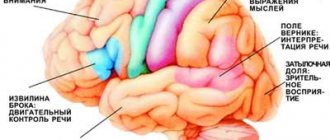Quite often, mental disorders are observed in older people. This is due to the natural aging process, which causes the functional state of the brain to deteriorate over time.
Along with other mental illnesses, presenile and senile psychoses are often found in older people. They are a consequence of the death of brain cells that can occur with age. Unfortunately, senile psychosis cannot be completely cured. But at the same time, it is not recommended to refuse treatment for senile psychosis altogether - it helps to weaken the symptoms of the disease and reduces the risk of patients causing harm to themselves and others. The likelihood of developing symptoms of psychosis depends on the person's age - as a rule, people aged 60 years and older are at risk.
At the age of 45-65 years, people develop mainly presenile psychosis, it is also called involutional .
Senile psychosis usually occurs after 65 years of age and manifests itself in the forms of depressive and paranoid disorders. Its symptoms depend on the form of manifestation.
The main cause of psychosis in the elderly is brain atrophy, but there are also specific factors that influence the development of the disease.
Symptoms of senile psychosis
- increased anxiety and depression;
- attacks of excessive suspiciousness (hypochondria);
- depressed mood, melancholy;
- the appearance of various forms of delusions, as well as hallucinations;
- lethargy or, conversely, overexcitation (agitated depression);
- attacks of confusion;
- decreased intelligence;
- increased suggestibility, stereotypical thinking.
In this case, psychosis gradually progresses and leads to a complete breakdown of the mental functions of the brain, that is, dementia.
How to get to our medical center
All you have to do is call 8(969)060-93-93 . The call center manager will provide all the necessary information. From him you will learn the methods and cost of the upcoming treatment. The consultant will help you choose a room. After making an appointment, all you have to do is drive to the clinic. Our hospital is located in a convenient location. Getting to it will not be difficult, either by public transport or by your own. In cases where there are problems with the client, you can order a transfer service from us. Our staff will deliver the patient using convenient transport. All types of diagnostics and therapy are provided anonymously.
Treatment of senile psychosis
As we said earlier, senile psychosis cannot be completely cured. Treatment of senile psychosis in older people does not have a specific method, but a properly selected set of therapeutic measures and regular care can alleviate the patient’s condition.
The consequences of progressive senile psychosis are such that an elderly person does not accept changes in his life at all, so you should not insist on placing such a person in a hospital. In this case, the most correct solution would be to call a psychiatrist at home, especially if the patient behaves aggressively, suffers from hallucinations or delusions.
What can a psychiatrist called to your home do?
First of all, he can determine a treatment regimen and give relatives the necessary recommendations related to the specifics of care and ensuring the safety of the patient and others. Treatment of psychosis is complex and includes the prescription of medications, as well as cognitive rehabilitation, which helps strengthen memory, attention and thinking and slows the progression of the disease.
| | Find out more about ]calling a psychiatrist to your home[/anchor] |
If your loved one needs help at home , we will help! Call us
Causes of diseases in old age
- Genetic predisposition;
- Atherosclerosis of cerebral vessels, hypertension, hypotension, diabetes mellitus in an advanced stage;
- Abuse of sleeping pills, drops containing alcohol, alcoholic beverages, psychoactive substances;
- A sharp change in the usual way of life;
- Exacerbation of chronic somatic disease or acute inflammation.
- Alzheimer's disease.
- Aging of the body.
During the period of exacerbation of these diseases, signs appear that may be symptoms of the development of psychosis.
Risk factors for the disease are:
- Sleep disturbances;
- Surgical interventions;
- Acute vitamin deficiency;
- Diseases of the organs of hearing or vision;
- Constant state of stress;
- Social isolation, loneliness, especially depression
- Traumatic brain injuries;
- Neoplasms in the brain.
Forecast and preventive measures
A stay in the hospital of our center with timely assistance provided gives reason to talk about a positive prognosis after treatment of acute conditions. Chronic psychotic forms, unfortunately, have an unfavorable course; doctors can only achieve temporary remission. After discharge, clients, under the supervision of relatives, should follow the recommended regimen, avoid neuropsychic overload, and treat existing pathologies of internal organs. When the first signs of exacerbation appear, simply dial 8(969)060-93-93.
| Vascular psychoses |
Mental disorders of vascular origin include a variety of psychotic and non-psychotic manifestations that occur with various vascular diseases of the brain - atherosclerosis, hypertension, cerebral thromboangiitis obliterans.
Systematization of mental disorders with the identification of individual nosological units is possible only in some cases; more often, a combination of various vascular lesions or the addition of others to existing vascular disorders is observed. The atherosclerotic process can be complicated by hypertension and, conversely, in the later stages of hypertension, atherosclerosis can occur. The same applies to arteriosclerosis and thromboangiitis. When analyzing mental disorders and psychoses of vascular origin, we will describe general disorders that characterize the entire group of vascular diseases of the brain, and we will try to identify disorders that are more characteristic of this or that vascular suffering.
All vascular diseases are characterized by certain symptoms - a vascular symptom complex. Firstly, dysmnestic disorders, which are usually combined with affective weakness and a tendency to emotion. These manifestations are accompanied by awareness of the disease to varying degrees and fussy helplessness. This symptom complex is the same for various vascular disorders. The second feature of mental damage during vascular suffering is that it gives the impression of severe cerebral suffering rather than mental suffering. With vascular processes, memory impairments are observed. Affective incontinence, sometimes episodes of confusion, i.e. disorders that occur with severe brain suffering (atrophies, tumors, etc.). You should pay attention to the fact that with all vascular diseases, an undulating course is observed, i.e. course with periodic improvements. With cerebral thromboangiitis, periods of improvement can last several years, with atherosclerosis and hypertension - less, but the appearance of intermittent psychoses from time to time, occurring with confusion, is still characteristic. Signs of the vascular symptom complex:
1. Combination of dysmnestic disorders with incontinence.
2. The impression of severe cerebral suffering.
3. Waviness of the flow.
Despite the variety of mental disorders in vascular diseases of the brain, E.Ya. Sternberg considered the taxonomy of vascular mental disorders without division into individual diseases to be the most convenient and meeting practical requirements:
1. initial, “non-psychotic” neurosis-like syndromes.
2. various syndromes of vascular dementia.
3. psychotic syndromes (syndromes of exogenous type, affective, delusional occur in approximately 60% of patients, disorders of non-psychotic level, etc. - in less than 40%)
In this lecture we are trying to talk about mental disorders in vascular lesions based on their nosological division into three main vascular diseases. At the same time, we will try to highlight the features that primarily characterize this or that vascular process, with a description of the stages of pseudoneurasthenia, dementia and psychoses.
Let's start with atherosclerosis , which usually develops gradually, mental disorders appear unnoticed. The first symptoms that usually appear in patients from time to time are headache, heaviness in the head, noise in the head, flickering of spots before the eyes, dizziness. Sleep disorders arise - early awakening with the feeling that you will not fall back to sleep. Dizziness is accompanied by a feeling of nausea, sometimes patients feel a rush to the head. At this stage, increased fatigue is sometimes detected. Gradually, patients become more and more irritable, hot-tempered, and allow rudeness that was previously unusual for them. A tendency to emotion appears as a mild sign of affective incontinence. Absent-mindedness occurs as an early sign of memory impairment. The selective ability of memory is impaired, which affects the difficulty of reproducing names, surnames, and dates. Productivity disturbances are noted. It becomes difficult to quickly navigate the diverse demands of life. Rapid changes in the situation cause irritation and confusion in patients, this indicates a decrease in mental adaptation. Patients perform their usual work well. They can't do something new. The so-called manual skill decreases - work that requires precise movements becomes inaccessible. Handwriting changes, patients may drop objects, all their movements become less differentiated. Speech becomes clumsy - they cannot express their thoughts with the same clarity. They pronounce introductory phrases and provide unnecessary details. The mood is usually somewhat reduced. Anxious fears of a hypochondriacal nature may appear—patients often fear sudden death.
The disease moves into the second stage gradually. Manifestations of the disease are intensifying. Headaches become more and more painful. Dizziness may be accompanied by fainting, sometimes with instant loss of consciousness. Some patients experience epileptiform seizures. The gait becomes uncertain, the steps are short. Hand tremor appears. Speech sometimes becomes slurred, and paraphasia may occur. Memory suffers more and more - individual events from the past begin to fall out. At the same time, patients themselves often complain of forgetfulness. Phenomena of irritable weakness occur. Tearfulness is evident. The patients are becoming more and more confused. The consciousness of the disease is still there. Patients suffer from their irritability and poor memory.
Further, more severe atherosclerotic dementia develops - affective coarsening occurs, patients become selfish, annoying, talkative and fussy. Progressive amnesia occurs. Dementia goes from lacunar to total, i.e., consciousness of the disease is lost, a critical attitude towards one’s condition is lost. Speech becomes more monotonous, paraphasias occur more often, and persistent articulation disorders are noted. Patients have difficulty caring for themselves. Spatial disorientation may occur. Confabulations often occur. The mood is sometimes complacent, sometimes irritated and angry, sometimes confused and helpless. Patients sleep poorly at night and fall into a doze during the day. They become sloppy, often gluttonous. Insanity gradually sets in, interrupted by a stroke leading to death. There may also be a non-stroke course.
At the stage of atherosclerotic dementia, psychotic states arise; they develop either in the prodrome of a stroke, indicating a danger threatening the patient, or in the post-stroke period. Collectively they are referred to as states of confusion. The patients' speech is incoherent, they are restless, try to get up, and grab those passing by. Deeply disoriented, do not recognize others. These conditions are difficult to fit into the framework of ordinary stupefaction syndromes, since the psychopathological manifestations in them are characterized by atypicality, rudimentary, and syndromic incompleteness. Acute vascular psychoses are usually short-term (up to several hours), often occur at night, and are repeated many times. In contrast to acute symptomatic psychoses, the dynamics of acute vascular psychoses are characterized by frequent changes in various syndromes of stupefaction. In some cases, these psychoses have a more syndromic character; more often a state of so-called occupational delirium or oneiroid occurs. The occurrence of such conditions indicates the severity of the underlying suffering. Acute psychoses can give rise to subacute or so-called transitional intermediate psychotic states. Transitional psychoses, thus, can be associated with states of altered consciousness, but they can also occur independently, which causes significant diagnostic difficulties. As transient psychoses, pseudoparalytic states and Korsakov's amnestic syndrome are more often observed, as well as prolonged asthenodepressive states, anxious depressions, hallucinatory-delusional psychoses and apathetic-abulic states.
Particularly great diagnostic difficulties arise with the development of delusional and depressive psychoses; sometimes such conditions must be differentiated from endogenous or endoform psychoses of other origins.
With hypertension in the initial pseudoneurasthenic stage, there is increased irritability, loss of self-control, and hyperesthesia to previously ineffective stimuli . Fatigue and exhaustion are significantly pronounced. Irritability becomes a particularly characteristic phenomenon for the psyche of patients with hypertension - patients “flare up” at the slightest provocation. There is fussiness with elements of weakness. A kind of asthenization of the personality occurs - indecision, timidity and previously unusual doubts about one’s capabilities appear. Characteristic is the appearance of vague anxiety, fear of imaginary misfortune. There are attacks of sharp headaches with a feeling of excruciating pressure in the back of the head and forehead, noise in the ears and head. Dizziness and a feeling of constant staleness in the head often occur. For this stage of hypertension, paroxysmal disorders are quite characteristic - fainting, absence seizures, speech paroxysms (transient dysarthria, paraphasia). Suddenly, nystagmus, numbness of the fingers, weakness in one half of the body, flickering of spots before the eyes, and sudden onset of deafness or blindness may occur. Psychotic states are more syndromic in hypertension than in a pure atherosclerotic process. Oneiric and twilight stupefactions and delirious states are observed.
Paroxysmal states and psychoses in hypertension tend to recur. With hypertension, pseudotumor syndrome can develop, which occurs with painful headache, vomiting, and increased blood pressure. Phenomena of a congestive nipple may develop in the fundus, consciousness is upset - first there is obnubilation, then a state of stunning. Patients are lethargic and apathetic. Korsakov's amnestic syndrome is often observed. To differentiate such conditions, a study of the cerebrospinal fluid is required, as well as measures to lower blood pressure, leading to the disappearance of this syndrome.
In the later stages of hypertension, pseudoparalytic syndrome and Korsakoff amnestic syndrome can develop, as well as subacute psychoses in the form of anxious and melancholy states reminiscent of involutional melancholia and delusional psychoses. Delusional psychotic states occur with a plot of persecution, poisoning, damage, sometimes they are called irritable paranoids due to the particularly pronounced irritability and anger of patients. Irritability alternates with episodes of complacency. As a result of a long-term disease, the above-described vascular dementia develops. It occurs after strokes, prolonged vascular spasms, and in rare cases, with a non-stroke course.
Cerebral thrombangitis is a vascular disease of the brain that occurs with the formation of blood clots and vascular sclerosis. It begins at the age of 25-35 years, sometimes a little later; more often in men than in women. The disease is chronic in nature, occurring in the form of acute attacks with long-term remissions. The onset of the disease is usually acute with the sudden onset of painful headaches such as migraines, flashing before the eyes, dizziness and vomiting. Absence seizures or epileptiform seizures may develop. In the initial stage of the disease, twilight stupefactions can sometimes occur, and cases of sudden development of pseudodementia have been described. This is followed by fairly long remissions. Acute attacks may be repeated. With further progression of the disease, as painful phenomena become more frequent, persistent asthenia develops, then the phenomena of vascular dementia with severe memory impairment, affective incontinence, lethargy, and helplessness. With cerebral thromboangiitis, anxiety-depressive, catatonic, hallucinatory-delusional psychoses are also described, which in some cases can become chronic after previous acute attacks of the disease. In some cases, there is a need for differential diagnosis of these psychoses with psychoses of procedural origin.
An independent variant of vascular dementia is an Alzheimer-like form with focal cortical disorders caused by a special localization of the vascular process (T.I. Geyer, V.M. Gakkebusch, A.I. Geimanovich, 1912). A.V. Snezhnevsky (1948) described Alzheimer-like clinical pictures that arise as a result of the addition of atherosclerotic changes in the vessels of the cortex to the senile-atrophic process. Similar clinical pictures can develop with a purely vascular nature of the disease.
Endoform protracted or chronic vascular psychoses cause significant diagnostic difficulties . With them, it is often not possible to detect direct cause-and-effect relationships between the characteristics of the course of the vascular process and the development of endomorphic psychotic states. In some cases, the latter can be quite easily attributed to psychoses of a vascular nature, because in these cases, psychoorganic disorders are significantly expressed; in the past, exogenous psychotic episodes were noted. The vascular genesis of these psychoses may be evidenced by the simplicity and rudimentary nature of their psychopathological manifestations.
In some cases, endoform psychoses are difficult to differentiate from psychoses of an endogenous nature, provoked or modified by an accompanying vascular process. In the families of these patients, there is an accumulation of schizoid personalities. Premorbid characteristics of patients are also characterized by various variants of schizoid manifestations.
E.Ya. Sternberg described prolonged paranoid states as endoform vascular psychoses, which occur more often in men in the form of delusions of jealousy. The plot of delusions is usually poorly developed, delusional ideas are not sufficiently systematized, and a combination of ideas of jealousy and damage is often noted. The mood of patients is usually depressed, they are irritable, tearful, sometimes angry and aggressive.
E. Ya. Sternberg also classified chronic verbal hallucinosis, which usually develops after acute hallucinatory psychosis, as endomorphic vascular psychoses. These psychotic states are characterized by the presence of polyvocal true verbal hallucinosis, an undulating course, an increase in hallucinatory manifestations in the evening and at night, and a predominantly threatening content of hallucinations. Such psychoses can last for years without the emergence of automatisms or ideas of influence. Manifestations of hallucinatory delusions are developing, E.Ya. Sternberg also described prolonged vascular depression, pointing out the significant difficulties in distinguishing them from endogenous affective psychoses that first arise in old age in the presence of vascular disease. For nosological delimitation of these depressive states, it is necessary to involve all data from the anamnesis, study the genetic background and premorbid characteristics of patients.
Differential diagnosis of mental disorders in vascular diseases of the brain .
In addition to the differential diagnostic features indicated in the text of the lectures, it is worth mentioning the features that make it possible to differentiate the manifestations of the initial pseudoneurasthenic stage of vascular processes from neurotic disorders. You should pay attention to the presence of pronounced somatic signs of vascular diseases, and also take into account the features of neurotic disorders described in the text of the lecture. Help for differential diagnosis is the presence of dysmnestic disorders, sometimes paroxysmal conditions, at the pseudoneurasthenic stage.
To distinguish senile-like vascular dementia from senile dementia, attention should be paid to the more acute onset of the disease during vascular processes, the undulating course, and the presence of acute psychotic episodes. The occurrence of senile-like vascular dementia is apparently associated not only with age-related involution of the brain, but also with the predominance in old age of diffuse forms of the atherosclerotic process and secondary atrophy of the cerebral cortex.
For the treatment of vascular psychoses, aminazine in small doses, sonapax, small doses of haloperidol or tizercin are used. Combining medications should be done very carefully, given the possibility of developing exogenous psychotic states. Treatment with amitriptyline, which especially often leads to the development of exogenous episodes, should be carried out very carefully. In some cases, in the early stages of the disease, treatment with nootropics in combination with aminazine is advisable.
When predicting vascular psychoses, the dynamics of psychotic states should be taken into account. The transition of episodes of upset consciousness into asthenodepressive or asthenic states usually indicates a more favorable prognosis.
When episodes of upset consciousness are replaced by more severe psychoorganic manifestations, one can think about the possibility of a fairly rapid development of vascular dementia. When acute vascular psychoses occur, there is a known correlation between the severity of the underlying disease and the development of psychosis; in prolonged endoform psychoses, such a correlation cannot be established.
BIBLIOGRAPHICAL LIST
1. Zhislin S.G. Essays on clinical psychiatry. M.: Medicine, 1965.
2. Orlovskaya D.D. Pathological anatomy of psychoses, M.: 1961, T 1, pp. 158-187.
3. Shmaryan A.S. Brain diseases and mental disorders associated with them. M.: Medgiz. 1949.
4. Shumsky N.G. Vascular diseases of the nervous system: Sat. proceedings of the All-Russian 6th Congress of Neuropathologists and Psychiatrists. 1975. T.2.
5. Shumsky N.G. On the issue of vascular depression in late age; Questions of psychoneurology, M.: 1965, pp. 466-471.
6. Sternberg E.Ya. Vascular diseases of the brain. Manual of Psychiatry. M.: Medicine, 1963, T.2. From 93-107.







